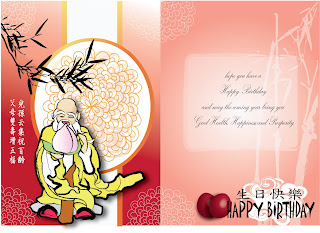
Title: Birthday Card
Culture: Chinese Culture
Target: Older generation for example parents and grandparents.
How I celebrate my birthday:
For Chinese, we have 2 birthdays since Chinese tradisonal way to count date is different. My parents used to celebrate my birthday according to the Chinese's date. My mother will prepare 2 eggs for my breakfast. Then, she will give my angpau as a sign for good luck in the coming year. If according to the Western's date, usually I will celebrate with my friends. We will be gathered in a restaurant, having fun there. Last but not least, there will be a cake and presents.How I celebrate my birthday:
Description for the birthday card:
As written in the previous post, this birthday card is designed especially for the old generation. Thus, the elements that I used in designing the card are more to Chinese's traditional style.
'Shou', is a god that represents long life in Chinese's beliefs. 'Shou' is holding a peach in his hands, wishing someone good luck and long life.
Bamboos are often drawn by Chinese artists in their masterpieces. I add bamboos to my birthday card to make the card looks more attractive.
Circle in the middle-round symbolize gathering. It brings a message that we should spare our time to celebrate birthday with our parents. For them, this will the best present for their birthday.
Red eggs- tradisional present.
Chinese poems-wishing parents and grandparents all the best.
Red colour for the background- tradisional colour for Chinese. Chinese especially older generation believes red can brings good luck or good fortune.






















